Tired of your small nyash, (buttock) check these exercise that will help you in few days of consistency and strategy attain a bigger and firmer butt.
When it comes to body sculpting and enhancement, targeted exercises are a game-changer, particularly in areas like the buttocks which are a focal point for many fitness enthusiasts.
I understand that the desire to have the body shape you desire might be quite a challenging one if you don’t know what to do or where to start.
Well, I have had the opportunity to help young and old ladies like you reach their fitness goals not only in looks, but in the general wellbeing through the right exercises.
The pursuit of a firmer, well-shaped butt is not just about aesthetics; it’s about power, strength, and the body’s overall balance.
Attention; Best Unique Fun Exercises For Girls At Home
The right set of exercises can significantly enhance the size and shape of your buttocks, transforming not just how you look, but also how you feel.
For women looking to embark on this journey, the good news is that these exercises are designed to cater to various fitness levels.
Whether you’re a beginner just stepping into the world of fitness or an experienced gym-goer looking to target specific areas, there’s a range of exercises tailored to meet your needs.
This inclusivity ensures that anyone can participate and benefit from these workout routines.
But the advantages of these exercises extend far beyond the mirror. Engaging in regular, targeted butt exercises can lead to improved posture, a common concern in our increasingly sedentary lifestyle as I stated earlier.
Top 10 exercise gears you might need for these exercises
When undertaking a fitness regimen focused on enhancing butt size, having the right exercise gear can make a significant difference in both your performance and comfort.
- Resistance Bands
- Yoga Mat
- Comfortable Athletic Shoes
- Dumbbells
- Ankle Weights
- Kettlebells
- Foam Roller
- Exercise Bench
- Stability Ball
- Workout Clothing
What you must know about these butt exercises
Before I proceed, it’s important to understand the basics of how these workouts impact your body. This foundational knowledge will not only help you perform the exercises more effectively but also allow you to appreciate the changes your body undergoes during this fitness journey.
Anatomy of the Buttocks
- The butt is composed of three major muscles: the gluteus maximus, medius, and minimus. Each of these muscles plays a unique role in shaping your buttocks and supporting your lower body.
- The gluteus maximus, being the largest muscle in the body, is responsible for the shape and size of your butt. It also plays a crucial role in movements like standing up from a sitting position, climbing stairs, and maintaining an upright posture.
- The gluteus medius and minimus, though smaller, are vital for hip stabilization, especially during activities where you balance on one leg.
How Exercise Can Enhance Your Butt
- Regular and targeted exercises can stimulate muscle growth (hypertrophy) in the gluteal muscles, leading to an increase in size and better definition.
- Strength training exercises that focus on the buttocks not only improve muscle tone but also enhance fat burning, which can help in revealing the shape of the glutes.
- Consistency in these exercises is key. The changes in muscle size and strength happen over time, requiring dedication and regular workout sessions.
The Importance of Consistency and Proper Diet
- Consistent training is essential for muscle growth and development. It’s not just about the intensity of the workouts but also about how regularly you perform them.
- A diet rich in protein, healthy fats, and complex carbohydrates plays a significant role in supporting muscle growth and recovery. Ensuring your body gets the right nutrients is as important as the exercise regimen itself.
- Hydration and proper rest are crucial. Muscle repair and growth predominantly occur during rest periods, including sleep, highlighting the importance of good sleep hygiene and adequate water intake.
Top 5 Butt-Enhancing Exercises
- Squats
- Lunges
- Hip Thrusts
- Donkey Kicks
- Glute Bridges
Since you have waited to this very point, I want to first and foremost, congratulate and appreciate you for your resilience.
Having established a solid understanding of the basics, it’s time to focus on the core of your workout regime.
Here are the top five exercises specifically chosen for their effectiveness in enhancing butt size.
These exercises are designed to target the gluteus maximus, medius, and minimus, providing a comprehensive workout for your buttocks.
Squats
Squats are the quintessential exercise for butt enhancement. They primarily target the gluteus maximus and also engage the thighs and lower back.
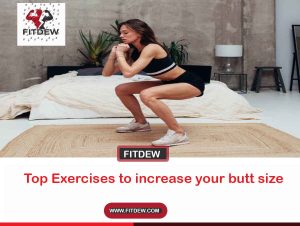
They are effective for building strength, enhancing size, and improving the overall shape of your butt. You can see alternative exercises to Squats.
How to perform squat
- Stand in a squat position with your feet slightly wider than shoulder-width apart, arms at your sides.
- Lower your body until your thighs are parallel to your knees. As you squat, move your arms out in front of you, palms together.
- Propel yourself up and off the ground. Try to push your feet at least 3 inches off the ground. Extend your arms to help with momentum.
- Squat back down with soft, bent knees, and repeat.
- Complete 3 sets of 10 to 15 repetitions.
Lunges
Lunges are excellent for targeting the gluteus medius and minimus. They also help improve balance and coordination.
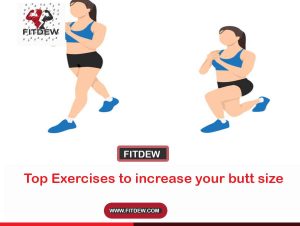
How to perform Lunges
- Hold a dumbbell in each hand with your arms at your sides.
- Stand with feet about hip-distance apart. Step forward about 2 feet with your left foot.
- Bend your left knee toward the ground until it’s parallel to the floor. This is the forward lunge position.
- Pause and hold this position for a few seconds.
- Then take a step forward with your back (right) leg, and repeat the lunge leading with this leg.
- Repeat this walking lunge pattern, alternating legs for 20 repetitions (10 each leg).
- Complete 2 sets of 20 repetitions.
Hip Thrusts
Hip thrusts are pivotal for targeting the glutes without over-engaging the thighs. They’re particularly effective for the gluteus maximus.
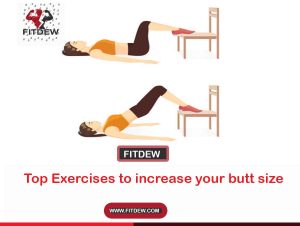
How to perform Hip Thrusts
Sit on the ground with a bench behind you. Lean against the bench so that your shoulder blades are near the top.
Drive through your feet, thrusting your hips upwards, and squeezing your glutes at the top. Return to the starting position.
Donkey Kicks
This exercise isolates the glutes and helps in shaping the butt.
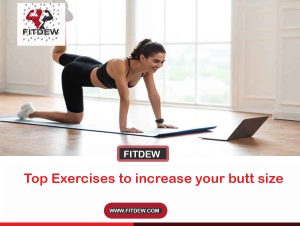
How to perform Donkey Kicks
- Start by positioning yourself on all fours. Keep your knees hip-width apart, your hands flat on the floor under your shoulders, and your spine neutral.
- Brace your core, then lift your right leg off the floor, keeping your right knee bent and your foot flat.
- Use your glute muscles to push your foot toward the ceiling. Pause and squeeze at the top. Make sure your pelvis and hips remain pointed toward the ground.
- Return to the starting position.
- Complete 15 reps on each leg for 3 sets.
Glute Bridges
Glute bridges focus on the gluteus maximus and help in building a rounder butt.
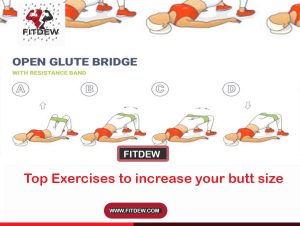
How to perform Glute Bridges
Lie on your back with knees bent and feet flat on the ground. Lift your hips off the ground until your knees, hips, and shoulders form a straight line.
Squeeze your glutes hard and keep your abs drawn in so you don’t overextend your back during the exercise.
How to plan these Exercises Into Your Routine
Now that you’re equipped with the top exercises for enhancing your butt, the next step is to effectively integrate them into your workout routine.
A well-structured plan not only ensures balanced development but also helps in avoiding overtraining and injuries.
Creating a Weekly Exercise Plan
Aim to target your glutes 2-3 times a week. This frequency allows for adequate muscle recovery while still providing enough stimulus for growth.
Mix and match the exercises provided to keep your workouts varied and engaging. For instance, you could do squats and lunges on one day, followed by hip thrusts and glute bridges on another. Ensure you have rest days in your schedule. These are crucial for muscle recovery and growth.
The Importance of Rest and Recovery
Pay attention to what your body tells you. If you feel excessive soreness or fatigue, it may be a sign to take it easy and allow more recovery time.
Engage in light activities such as walking, yoga, or stretching on rest days. This can help in muscle recovery and reduce soreness.
Equally ensure you get enough sleep. Good sleep is essential for muscle repair and recovery. Aim for 7-9 hours of quality sleep each night.
Nutrition Tips for Muscle Growth and Recovery
- Protein Intake: Protein is crucial for muscle repair and growth. Include a source of lean protein in every meal, such as chicken, fish, tofu, legumes, or dairy products.
- Balanced Diet: Ensure your diet is well-rounded, including a balance of proteins, carbohydrates, and healthy fats. Carbohydrates are essential for energy, while fats are vital for hormone production, including those needed for muscle growth.
- Meal Timing: Consider the timing of your meals. Eating a combination of protein and carbs after your workout can aid in muscle recovery and growth.
Concluding remark on the Top Exercises to increase your butt size
As we wrap up our exploration of the best exercises to enhance butt size and the various supportive strategies, it’s important to reflect on the journey you’re about to embark on.
Enhancing your butt size through exercise is a commitment to not only improving your physical appearance but also boosting your overall health and strength.
It’s essential to approach this fitness journey with patience and persistence. Changes in muscle size and shape take time and consistent effort.
Celebrate the small victories along the way, and don’t be discouraged by setbacks. Each step forward is a move towards your goal.
Recommendations
Disadvantages of drinking water during exercise
Aerobic and Anaerobic Exercise Examples
7 Early Morning Exercise Benefits
Importance of hydration during exercise
Role of gym instructor in promoting mental health through exercise